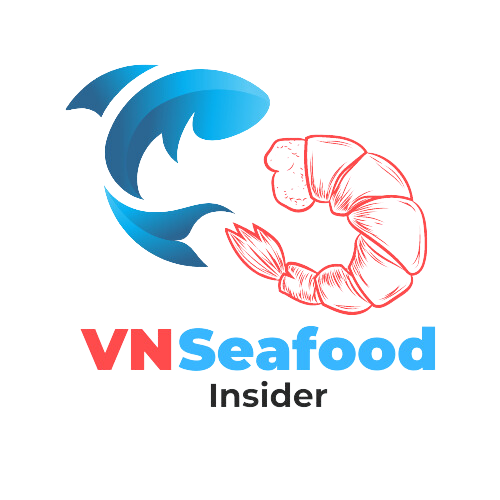The aquaculture industry has witnessed remarkable transformations in recent years, but few stories are as compelling as Vietnam Tilapia Farming revolution. At VNSeafoodInsider, we’ve been tracking this incredible journey from modest beginnings to becoming a significant player in the global tilapia market. What started as a supplementary farming activity has evolved into a lucrative industry that’s caught the attention of international buyers worldwide.
The numbers tell an extraordinary story: tilapia farm-gate prices in Vietnam have doubled from approximately $0.60 to $1.45 per kilogram in 2025, creating unprecedented opportunities for both farmers and international buyers. This dramatic price surge isn’t just a market anomaly—it’s the result of strategic farming innovations, export market expansion, and the development of sustainable aquaculture practices that are reshaping the industry landscape.
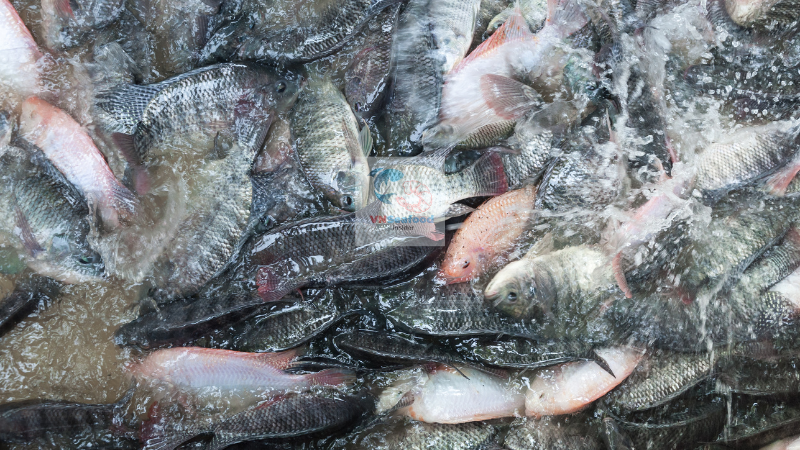
Outline
ToggleVietnam Tilapia Farming Overview and Market Potential
Vietnam’s emergence as a major tilapia producer has been nothing short of remarkable. The country’s Vietnam Tilapia Farming industry has experienced exponential growth, with current production reaching approximately 300,000 metric tons annually. This impressive figure represents just the beginning of what experts predict will be a sustained expansion trajectory.
The export value alone tells a compelling story of market success. In 2024, Vietnam’s tilapia exports doubled from $17 million to $41 million, demonstrating the growing international demand for Vietnamese-produced tilapia. This surge in export value reflects not only increased production volumes but also improved quality standards and market positioning.
Looking ahead, the Vietnamese government has set ambitious targets for the Vietnam tilapia export market. Industry projections indicate that production could reach 400,000 tons by 2030, representing a 33% increase from current levels. This growth trajectory is supported by expanding key export markets, including the United States, Brazil, and various regional markets across Asia and Latin America.
The strategic positioning of Vietnamese tilapia in international markets has been particularly noteworthy. Unlike many competitors who focus solely on volume, Vietnamese producers have emphasized quality and sustainability, creating a premium market position that commands higher prices and better profit margins.
Integrated Tilapia Shrimp Farming Systems in Vietnam
The heart of Vietnam Tilapia Farming success lies in its innovative integrated tilapia shrimp farming systems. Tra Vinh Province serves as a perfect case study for this revolutionary approach, where farmers have transformed traditional shrimp farming into a highly efficient dual-species operation.
In districts like Cau Ngang, Tra Cu, and Chau Thanh, farmers have embraced rotational farming systems that maximize pond utilization throughout the year. This approach involves cultivating tilapia in existing shrimp ponds during off-seasons, creating a continuous production cycle that optimizes resource utilization.
The technical specifications of these systems are impressive. Farmers maintain a stocking density of approximately 10 fish per square meter, which provides optimal growth conditions while preventing overcrowding. The farming cycle spans five months, during which tilapia reach an average weight of 700-750 grams—ideal for both domestic consumption and export markets.
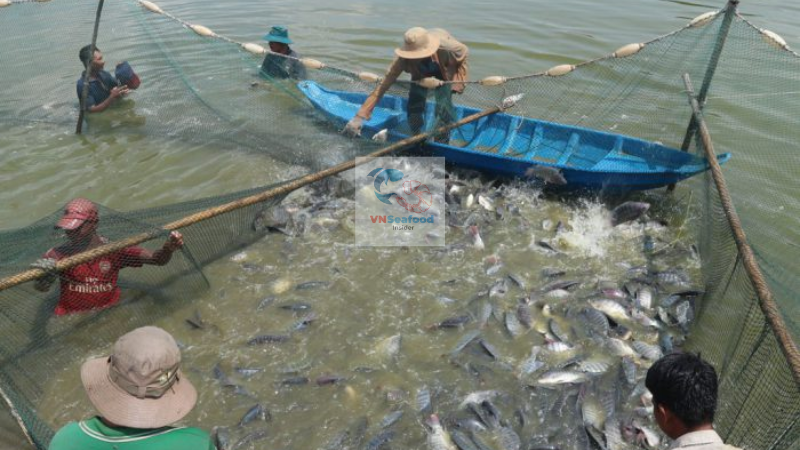
Perhaps most importantly, this integrated approach delivers significant water quality improvement benefits. Tilapia naturally consume excess feed and organic waste, reducing bacterial loads and pathogens that typically affect shrimp populations. This biological cleaning process creates healthier aquatic environments for subsequent shrimp crops, improving overall farm productivity and sustainability.
Economic Benefits of Integrated Farming
The economic transformation has been dramatic. In Tra Vinh Province, tilapia prices have increased from 15,000 VND to 36,000 VND per kilogram (approximately $0.60 to $1.45), primarily driven by expanding export opportunities to the US market. This price doubling has fundamentally changed the economic landscape for Vietnamese aquaculture farmers.
Profit margins have become particularly attractive, with farmers earning approximately 10,000 VND per kilogram after deducting all production costs. This represents a healthy profit margin that makes Vietnam Tilapia Farming economically viable as either a primary or supplementary income source.
The integrated farming system also provides significant cost reduction benefits. By utilizing existing shrimp pond infrastructure, farmers avoid substantial capital investments in new facilities. Additionally, the biological synergies between tilapia and shrimp cultivation reduce feed costs, medication expenses, and water treatment requirements.
Disease prevention advantages represent another crucial economic benefit. Tilapia’s natural resistance to many common aquaculture diseases reduces veterinary costs and production losses, contributing to more predictable and stable revenue streams.
Vietnam Tilapia Fish Farming Methods and Techniques
Modern tilapia fish farming methods in Vietnam have evolved significantly from traditional practices. Successful operations begin with proper pond preparation and design, typically featuring depths of 1.5-2 meters with adequate drainage and water circulation systems.
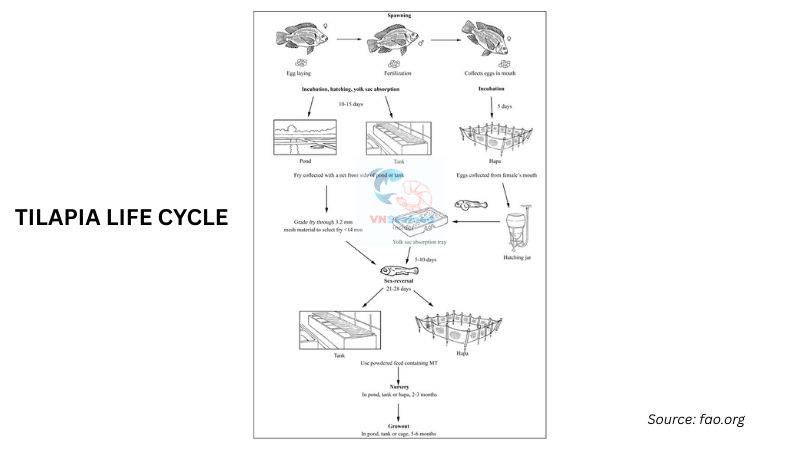
Water management systems form the backbone of successful Vietnam Tilapia Farming. Farmers maintain optimal water quality through regular monitoring of pH levels (6.5-8.5), dissolved oxygen content (minimum 4 ppm), and temperature ranges (26-30°C). Advanced operations utilize aeration systems and biofilters to maintain consistent water quality parameters.
Feed management and nutrition protocols have become increasingly sophisticated. Vietnamese farmers typically use high-protein feeds (28-32% protein content) during the initial growth phases, transitioning to maintenance feeds (24-28% protein) as fish approach harvest size. Feeding schedules are optimized to maximize growth rates while minimizing feed waste and environmental impact.
Disease prevention protocols emphasize biosecurity measures, including pond sterilization between crops, quarantine procedures for new stock, and regular health monitoring. These preventive approaches have proven more effective and economical than reactive treatment strategies.
Harvest procedures and post-harvest handling ensure product quality meets international standards. Farmers coordinate harvest timing with processing facilities to minimize stress and maintain fish quality throughout the supply chain.
Quality Control and Certification Standards
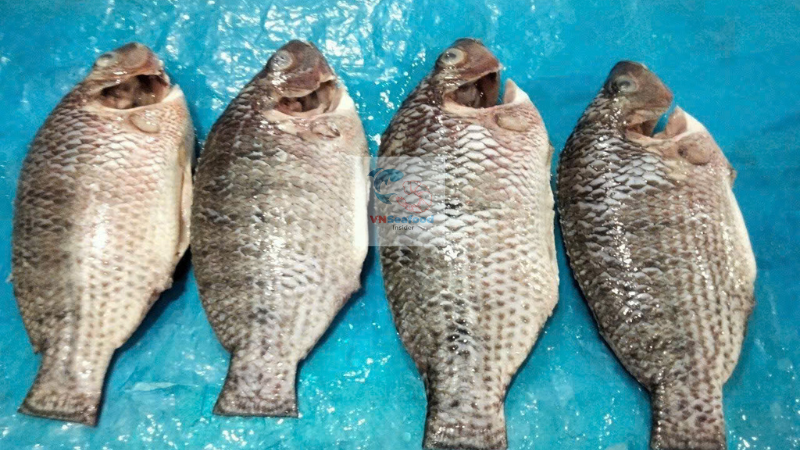
The Vietnamese government has implemented comprehensive certification programs to ensure export quality standards. Currently, over 2,300 certified aquaculture households operate in Tra Vinh Province alone, with certifications concentrated in Duyen Hai District, Duyen Hai Town, and other key farming areas.
Biosecurity measures include strict protocols for pond access, equipment sterilization, and visitor management. These measures prevent disease introduction and ensure consistent product quality across different Vietnam Tilapia Farming operations.
Export certification requirements encompass food safety standards, traceability systems, and environmental compliance measures. Vietnamese farmers must demonstrate adherence to international standards including HACCP, GlobalGAP, and specific importing country requirements.
Sustainable farming practices have become integral to certification programs. These include responsible feed sourcing, waste management systems, and water conservation measures that align with global sustainability trends.
See another article: 5 Common Mistakes When Importing Tilapia from Vietnam
Key Tilapia Farming Regions in Vietnam
Tra Vinh Province leads Vietnamese tilapia production with approximately 106 hectares dedicated specifically to export markets. This concentrated production allows for specialized infrastructure development and economies of scale that benefit the entire regional industry.
The broader Mekong Delta region provides ideal conditions for Vietnam Tilapia Farming, with abundant freshwater resources, favorable climate conditions, and established aquaculture infrastructure. This region’s extensive canal system facilitates water management and product transportation.
Specific districts including Cau Ngang, Tra Cu, and Chau Thanh have emerged as specialized tilapia farming zones. These areas benefit from concentrated technical expertise, shared infrastructure, and collaborative marketing approaches that strengthen the overall industry.
Duyen Hai District has become particularly noteworthy for its high concentration of certified operations. The district’s proximity to processing facilities and export infrastructure makes it an ideal location for export-oriented Vietnam Tilapia Farming.
Vietnam Tilapia Export Market Opportunities
The Vietnam tilapia export market presents numerous opportunities for international buyers. US market growth potential remains particularly strong, with Vietnamese producers well-positioned to meet growing demand for sustainable, high-quality tilapia products.
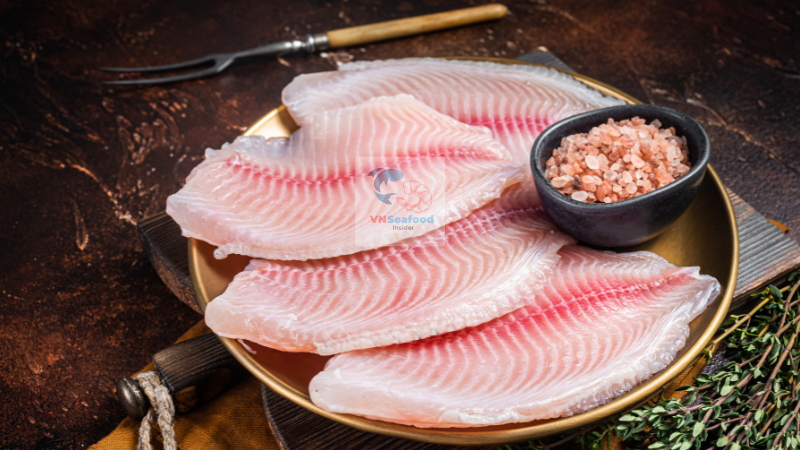
Export classifications include frozen whole fish, fresh chilled products, dried preparations, and value-added fillets. Each category serves different market segments and price points, allowing buyers to select products that match their specific requirements.
International trade utilizes standardized HS codes (Harmonized System codes) that facilitate customs clearance and documentation. Vietnamese exporters have developed expertise in international trade requirements, simplifying procurement processes for overseas buyers.
Market pricing and trends indicate continued growth potential. While global tilapia markets face competition from various producing countries, Vietnam’s focus on quality and sustainability provides competitive advantages in premium market segments.
See another post: Top five tilapia producers in vietnam
Export Requirements and Supply Chain
Quality standards for international markets require comprehensive documentation and certification. Vietnamese exporters maintain detailed records covering everything from feed sources to processing conditions, ensuring full traceability throughout the supply chain.
Processing and packaging requirements vary by destination market but generally emphasize food safety, proper labeling, and packaging integrity. Vietnamese processors have invested in modern facilities that meet international standards for hygiene and quality control.
Cold chain management systems ensure product quality from harvest through delivery. This includes proper ice handling, temperature monitoring, and logistics coordination that maintains product integrity throughout international transportation.
Documentation requirements include health certificates, origin certificates, and quality assurance documentation. Vietnamese exporters have streamlined these processes to minimize delays and ensure smooth international transactions.
Challenges and Solutions in Vietnam Tilapia Farming
Market competition with other producing countries remains a significant challenge. However, Vietnamese producers have addressed this through quality differentiation and sustainable farming practices that command premium prices in international markets.
Sustainability concerns have been proactively addressed through integrated farming systems, responsible feed sourcing, and environmental monitoring programs. These initiatives position Vietnamese tilapia as an environmentally responsible choice for conscious consumers.
Technical challenges including disease management and feed optimization continue to evolve. Vietnamese farmers have responded through continuous education, technology adoption, and collaborative problem-solving approaches that strengthen the entire Vietnam Tilapia Farming industry.
Government support programs provide crucial backing for industry development. These include technical assistance, export promotion, and infrastructure development initiatives that support continued growth and competitiveness.
Future Prospects and Industry Development
Production expansion plans indicate continued growth potential. The target of 400,000 tons by 2030 represents realistic growth based on current trends and market demand projections.
Technology adoption including automated feeding systems, water quality monitoring, and genetic improvement programs will drive continued efficiency gains and product quality improvements in Vietnam Tilapia Farming.
Partnership opportunities with enterprises create value-added opportunities for farmers. These collaborations provide market access, technical support, and financial stability that benefit all stakeholders.
Sustainable development initiatives ensure long-term industry viability. These programs balance economic growth with environmental protection, creating a foundation for sustained success in international markets.
See more: Top 5 exotic vietnam white fish that the importers should consider
How to Source Tilapia from Vietnam: Buyer’s Guide
Selecting reliable suppliers requires careful evaluation of certifications, production capacity, and quality control systems. At VNSeafoodInsider, we recommend focusing on suppliers with established track records and proper certifications.
Quality assessment criteria should include product specifications, processing standards, and supply chain reliability. Vietnamese suppliers generally provide detailed quality documentation and welcome buyer inspections.
Pricing negotiation strategies should consider volume commitments, payment terms, and long-term partnership potential.
Logistics and shipping considerations include container capacity, delivery schedules, and documentation requirements. Vietnamese exporters have developed efficient logistics networks that ensure reliable delivery to international markets.
The Vietnam Tilapia Farming industry represents a remarkable success story of innovation, sustainability, and market development. For international buyers seeking reliable, high-quality tilapia sources, Vietnam offers compelling opportunities in a rapidly growing market.
With its integrated farming systems, quality certifications, and strategic export positioning, Vietnam Tilapia Farming continues to set new standards in the global aquaculture industry. If you’re in demand of Tilapia products, please feel free to contact us.
